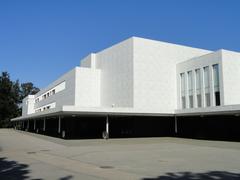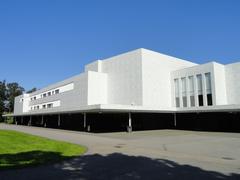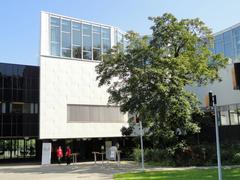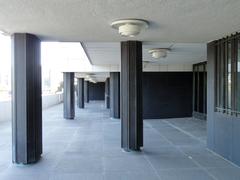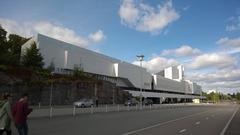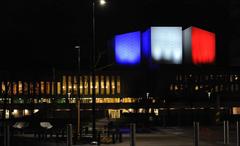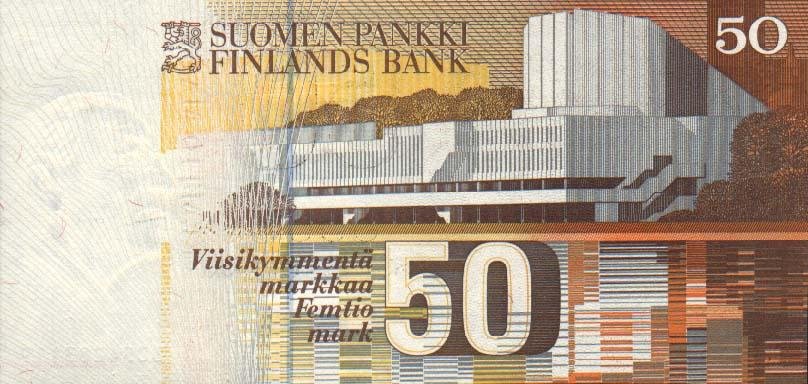
Finlandia Hall Helsinki: Visiting Hours, Tickets, and Comprehensive Visitor Guide
Date: 14/06/2025
Introduction: The Significance of Finlandia Hall in Helsinki
Finlandia Hall stands as a hallmark of Finnish architectural innovation and cultural identity. Designed by Alvar Aalto between 1967 and 1971, this iconic venue on Töölö Bay is a living testament to Finland’s post-war transformation into a modern, independent nation. Aalto’s “total work of art” philosophy is evident in every detail, from the luminous white Carrara marble façade to the harmonious integration of interiors and surrounding landscapes (finlandiatalo.fi; architecturaldigest.com).
Finlandia Hall is renowned not only for its architecture but also as a hub of pivotal international events, including the 1975 OSCE Summit, and as a vibrant setting for concerts, conferences, and state visits. Its recent renovation (2022–2025) preserved Aalto’s legacy while introducing modern amenities, expanded public access, and new cultural experiences (yle.fi; finnishdesignshop.com).
Located at the heart of Helsinki with panoramic views of Töölö Bay and within walking distance of the National Museum and Helsinki Music Centre, Finlandia Hall offers locals and tourists an immersive journey into Finnish design, history, and creativity (finlandiatalo.fi; visit.alvaraalto.fi).
Contents
- Origins and Historical Context
- Alvar Aalto’s Vision and Design Philosophy
- Architectural Features
- Exterior Design
- Interior Spaces
- Integration with the City and Nature
- Visitor Information: Hours, Tickets & Accessibility
- Renovation and Modernization (2022–2025)
- Artistic and Cultural Significance
- World Heritage Aspirations and Legacy
- Key Annual Events
- Sustainability Initiatives
- Practical Visitor Tips
- Frequently Asked Questions (FAQ)
- Visuals and Media
- Related Articles
- Sources
Origins and Historical Context
Commissioned in 1959 as part of Helsinki’s urban renewal efforts, Finlandia Hall was envisioned as the centerpiece of a cultural axis along Töölö Bay. Only the Hall was realized from Aalto’s ambitious plan, making it a singular emblem of Finland’s aspirations and Aalto’s architectural genius (visit.alvaraalto.fi; finlandiatalo.fi). Construction began in 1967 and was completed in 1971; the congress wing opened in 1975, just before Aalto’s death (encyclopedia.design). The Hall rapidly became a venue for global events, notably the 1975 OSCE Summit attended by world leaders.
Alvar Aalto’s Vision and Design Philosophy
Alvar Aalto (1898–1976) was a pioneer of human-centric, organic architecture. His concept of the “total work of art” (Gesamtkunstwerk) meant that every element of Finlandia Hall – from the marble façade to custom-designed furniture and lighting – was purposefully crafted for harmony and function (architecturaldigest.com). The Hall’s design aimed to symbolize Finnish independence and identity, referencing the nationalistic spirit of Jean Sibelius’s “Finlandia” (finlandiatalo.fi).
Architectural Features
Exterior Design
The Hall’s exterior is clad in white Carrara marble, inspired by Mediterranean culture, and sits atop a contrasting black granite base. The marble reflects shifting Nordic light, a subtle nod to Finland’s long winters (finlandiatalo.fi; architecturaldigest.com). Asymmetrical forms, sloping towers, and fan-shaped balconies create organic, dynamic silhouettes. The building’s orientation maximizes bay views and blends seamlessly with surrounding parkland (thearchspace.com).
Interior Spaces
Inside, Aalto’s preference for natural materials, asymmetry, and human scale is evident. The marble staircases, lattice ceiling for acoustics, warm wood elements, and custom-designed details foster an atmosphere that is both grand and welcoming (encyclopedia.design). The understated interiors focus attention on performances and audiences rather than on decorative excess (finlandiatalo.fi).
Integration with the City and Nature
Finlandia Hall’s placement on Töölö Bay links it visually and physically with Helsinki’s urban fabric and natural landscape. Expansive windows and terraces provide sweeping views and connect interior spaces with the outdoors (finlandiatalo.fi). Proximity to cultural landmarks reinforces its role as a central hub (ribaj.com).
Visitor Information: Visiting Hours, Tickets & Accessibility
Visiting Hours
- Public Spaces:
- Mon–Tue: 09:00–19:00
- Wed–Sat: 09:00–20:00
- Sun: 11:00–18:00
Special hours apply during Finnish holidays (Finlandia Hall Services).
Tickets and Booking
- General Entry: Free for public areas, exhibitions, cafés, and shops.
- Events & Tours: Tickets required for concerts, conferences, and guided tours. Purchase via Tiketti or the Hall’s official site.
- Guided Tours: Available in Finnish and English, typically €10–€20 (Finlandia Exhibition).
Accessibility
- Step-free entrances, elevators, wheelchair-accessible restrooms, and reserved seating.
- Little Finlandia pavilion is also fully accessible (Finlandia Hall Accessibility).
Getting There
- Centrally located at Mannerheimintie 13 E, 00100 Helsinki.
- Reachable via trams, buses, and a 10–15 minute walk from the main railway station.
- Limited paid parking; public transport recommended (Visit Finland).
Renovation and Modernization (2022–2025)
The 2022–2025 renovation was the most comprehensive in Finlandia Hall’s history. Supervised by the Finnish Heritage Agency and Alvar Aalto Foundation, the project preserved architectural integrity while upgrading technical systems, sustainability, and accessibility (hel.fi). The marble façade was replaced with durable Lasa marble after years of testing for resilience (yle.fi). Original interior elements were restored, and new services introduced:
- Finlandia Café & Wine: Seasonal Finnish cuisine and curated wines in an Aalto-inspired setting (finnishdesignshop.com).
- Finlandia Bistro: À la carte restaurant blending Finnish and Mediterranean flavors.
- Finlandia Shop: Curated Finnish and Nordic design items.
- Finlandia Homes: Boutique apartments for overnight stays in restored staff flats (uava.org.uk).
The Hall is now open daily to the public without the need for tickets or reservations for general access (yle.fi).
Artistic and Cultural Significance
Finlandia Hall houses over 70 artworks from Finland’s leading artists, including Birger Kaipiainen’s “Swan” and Kimmo Schroderus’s “Entertainer’s Day Off” (hamhelsinki.fi). The Hall’s flexible spaces accommodate world-class concerts, international congresses, exhibitions, and community events, making it a dynamic center for the arts (finlandiatalo.fi).
World Heritage Aspirations and Legacy
Finlandia Hall is a candidate for UNESCO World Heritage status as part of a group of Aalto-designed buildings (ribaj.com). Its annual event calendar, international reputation, and architectural significance cement its legacy as a symbol of Finnish creativity and innovation (finlandiatalo.fi).
Sustainability Initiatives
Aligned with Helsinki’s goal of carbon neutrality by 2035, Finlandia Hall implements sustainable practices throughout operations:
- Energy-efficient lighting and insulation.
- Circular economy and waste management initiatives.
- Sustainable dining emphasizing local, organic ingredients.
- Encouragement of public transport and eco-friendly visitor practices (Finlandia Hall Sustainability; Circular Economy Roadmap).
Sustainability is central to all events, with a focus on digital materials, eco-friendly catering, and community engagement.
Practical Visitor Tips
- Arrive early to explore the lobby, terraces, and bay views—prime spots for photography.
- Use public transport to minimize environmental impact.
- Advance booking is recommended for popular events, tours, and Finlandia Homes accommodation.
- Family-friendly programs and interactive trails are available during open house days.
- Non-flash photography is permitted in public areas; check restrictions for performances or exhibitions.
Frequently Asked Questions (FAQ)
Q: What are Finlandia Hall’s visiting hours?
A: Public spaces are open Mon–Tue 09:00–19:00, Wed–Sat 09:00–20:00, Sun 11:00–18:00; event hours vary.
Q: Is there an entry fee?
A: No; general public access is free. Tickets are required for events and guided tours.
Q: How do I buy tickets?
A: Purchase online via Tiketti or at the venue.
Q: Is Finlandia Hall accessible?
A: Yes; step-free access, elevators, and accessible restrooms are available.
Q: Can I stay overnight?
A: Yes; book Finlandia Homes apartments via the official site.
Q: How do I get there?
A: Use trams, buses, city bikes, or walk. Limited parking is available.
Visuals and Media
- Incorporate images of the marble façade, interiors, and bay views for guides and online content.
- Use alt text such as “Finlandia Hall Helsinki exterior,” “Finlandia Hall tickets,” and “Helsinki historical sites” for optimal SEO.
- Interactive maps and virtual tours are available on the official site.
Related Articles
- Discover Helsinki Historical Sites: A Guide to the City’s Cultural Gems
- Exploring Alvar Aalto’s Architectural Legacy in Finland
- Top Cultural Venues in Helsinki for Art and Music Lovers
Sources
- encyclopedia.design
- yle.fi
- finnishdesignshop.com
- finlandiatalo.fi
- visit.alvaraalto.fi
- blog.iavm.org
- architecturaldigest.com
- hamhelsinki.fi
Call to Action
Plan your visit to Finlandia Hall for a blend of architectural wonder, cultural depth, and sustainability. Book guided tours, purchase event tickets, and stay updated via the official website and social media. Download the Audiala app for interactive maps and audio guides, and explore Helsinki’s rich tapestry of history and design.

